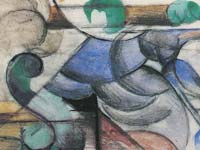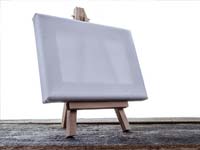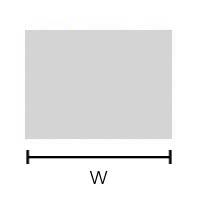A
Abrasion test The act of putting or exposing a material against the elements in order to determine their resistance to scratching under a specified set of conditions. Materials can include metals, composites, ceramics or thick spray coatings (such as the matte UV coatings sprayed on printed canvas). Fabrics are also put under abrasion test as well, to observe their durability, resistance and wear. |
| Abstract art An art style that avoids realistic and recognizable imagery, and instead depicts emotion through compositions of color and shape. Abstract art began to shift to the mainstream around the turn of the 20th century, as artists sought new ways to express their interpretations of the world. |
 |
| Acid-free Paper materials with a pH of around 7 are considered to be acid-free. These materials are less likely to harm artwork over time. Materials with a pH below 6.5 or above a pH of 8.5 are not considered acid-free. |
 |
| Alignment Marks Alignment marks, also known as registration marks, are visual indicators used in the printing process to ensure accurate and consistent positioning of multiple layers or colors. These marks are typically small, easily identifiable symbols or targets placed strategically on each layer of the artwork. By aligning these marks during the printing process, printers can ensure that each color or layer lines up correctly, preventing misalignment or offsetting issues that could affect the quality of the final print. Printers use alignment marks strategically placed on each layer of the artwork to ensure perfect registration, enabling the accurate superimposition of colors and layers in the Giclée printing process. |
| Alkaline Paper A pH neutral paper that is generally processed with calcium carbonate, the alkaline substance most commonly used in art production. Alkaline papers are acid-free and conservation-grade. |
| Allover Painting An artwork in which the entire surface is painted from corner to corner, with no one section receiving more attention or significance. Many of Jackson Pollock's Abstract Expressionism paintings can be defined as such. |
| Aluminyzed Prints Aluminyze prints are images infused directly into a sheet of aluminium using a hot press - a process called sublimation. The result? A vibrant and durable print with unparalleled colour and depth. |
| Analog Printing Analog printing in the context of Giclée refers to traditional printing methods that utilize physical processes, such as lithography or screen printing, to transfer an image onto a substrate. Unlike digital printing, which involves the direct reproduction of digital files, analog printing relies on mechanical or chemical means to create prints. While digital printing offers precise control and flexibility, analog printing methods often provide unique textures and characteristics that appeal to artists and collectors seeking a more tactile and artisanal aesthetic. |
| ANSI The American National Standards Institute. This national group determines the guidelines governing a wide variety of commercially produced goods. |
| Anti-Aliasing Anti-aliasing is a digital image processing technique used in Giclée printing to reduce the appearance of jagged or stair-stepped edges (aliasing) in computer-generated graphics or text. By smoothing out these edges through the blending of adjacent pixels, anti-aliasing creates a more natural and visually pleasing appearance, especially when images are scaled or displayed at different resolutions. This technique helps to maintain the smoothness and clarity of fine details in Giclée prints, resulting in crisp, high-quality reproductions of digital artwork. |
| Anti-Glare Coating An anti-glare coating is a specialized finish applied to the surface of Giclée prints to reduce glare and reflections, improving their visibility and readability under various lighting conditions. This coating typically consists of a microscopically textured layer that diffuses incoming light, minimizing specular reflections and glare without significantly affecting the color or sharpness of the printed image. Anti-glare coatings are especially beneficial for artworks displayed in brightly lit environments or areas with direct sunlight, enhancing the viewing experience and ensuring that the details of the print remain clear and visible. |
| Anti-Reflective Coating An anti-reflective coating is a thin, transparent layer applied to the surface of Giclée prints to minimize reflections and glare. Unlike anti-glare coatings, which diffuse light to reduce glare, anti-reflective coatings work by altering the refractive index of the surface, allowing more light to pass through and less to be reflected. This results in improved clarity and visibility of the printed image, particularly when viewing from different angles or under bright lighting conditions. |
Aqueous-Based Printers Aqueous-based printers, so called because the ink used is primarily water mixed with either dyes or pigments, are widely used for canvas printing and typically offer the best image quality.
Most print shops have moved to pigmented inks because these inks provide a more urable print than dye inks; pigmented inks are now the standard. |
Archival Archival framing means that all the materials involved in the process are completely acid-free. Your artwork is framed to last.
An original artwork can be considered archival if no irreversible treatments (such as lamination or dry mounting) are applied, and the framing products involved are of archival quality. |
| Archival Ink Pigment inks designed for longevity. These inks resist fading and produce conservation-grade prints that will last for decades. |
| Archival Products Any professional-grade fine art paper, mat board, backing or acrylic that is acid-free and constructed to maintain its color and condition, and protect the artwork, for approximately 100 years. |
| Archival-stub Framing materials designed to keep artwork undamaged and intact for as long as it is displayed (as many as 100 years), under moderate circumstances. Also called conservation-grade or museum-grade. |
| Art Paper Art paper refers to a high-quality, archival-grade paper specifically designed for Giclée printing and fine art reproductions. These papers are typically made from acid-free or cotton rag materials, which ensures longevity and prevents yellowing or deterioration over time. Art papers come in various weights, textures, and finishes to suit different artistic preferences and printing requirements, offering options such as smooth matte, textured watercolor, or glossy surfaces to enhance the visual impact of the printed artwork. |
Artist Canvas Any canvas material intended and prepared for painting or other art mediums. Artist canvas is available on rolls, or pre-mounted on wood frames. Today, most canvas is made from cotton and linen, though hemp was common in the past. The canvas may be primed or unprimed, depending on the artists preference.
Order online:
Mounted Artist Canvas
Rolled Artist Canvas |
 |
| Artist's Proof A term used to distinguish a small number of perfect example prints from an edition. Usually an extra 10% not included in the total number of a limited edition. Generally the property of the artist and numbered in Roman numerals. |
| Artwork Width When ordering a frame, you will be asked to provide a “width” measurement. This is always the horizontal measurement of the artwork you are framing. Measure your piece from left to right. It is important to ensure the ruler or measuring tape is straight (the same distance from the top on each side) and the recorded measurement is accurate to within 1/16th of an inch. |
 |
| Aspect Ratio The relationship between the height of your photo or artwork to its length is called the aspect ratio. |

